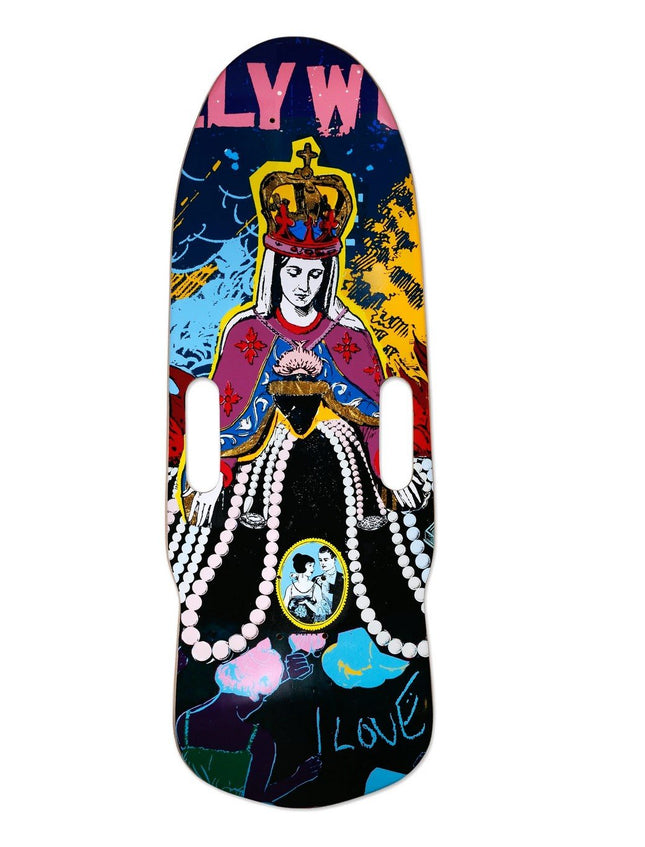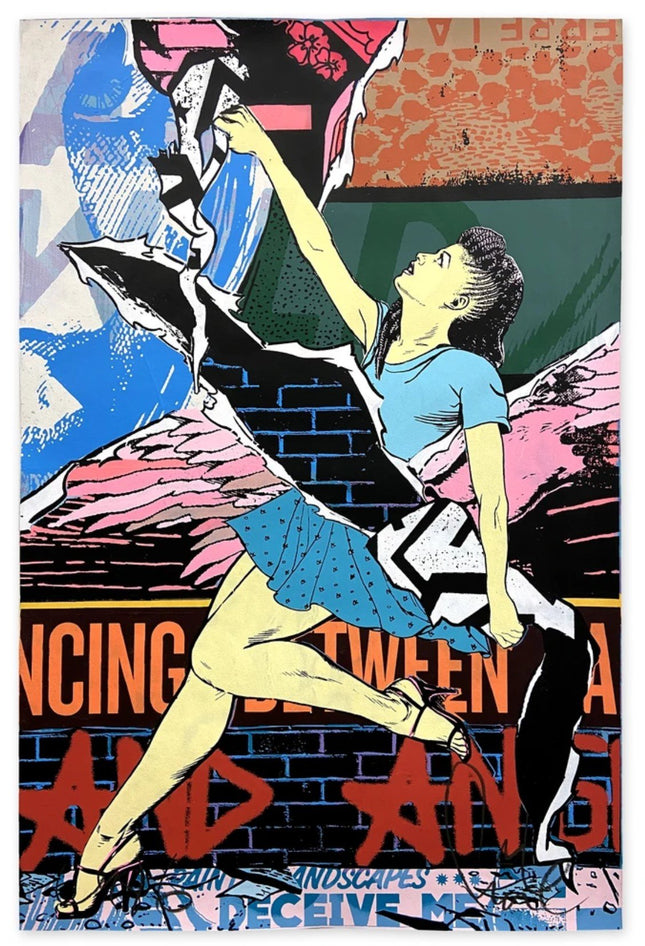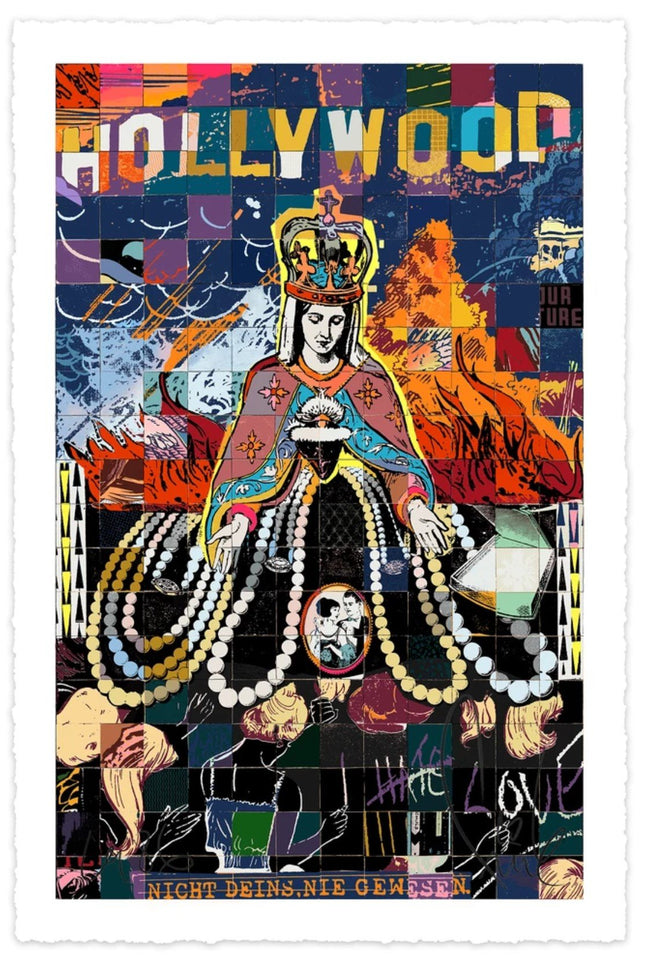
Religion
-

Faile Hollywood Deck Skateboard by Faile Silkscreen
Hollywood Deck Limited Edition Silkscreen Skateboard deck art by street pop culture artist Faile. FAILE Hollywood, 2019 9.5" x 28.5" 7 ply maple wood Edition of 150. Each deck comes with a COA signed by curator Roger Gastman that confirms the authenticity and edition size.
$676.00
-

Faile Dancing Between Angels/ Love Stories B-Side Silkscreen Print by Faile
I am dancing Between Angels/ Love Stories B-Side HPM 24-Color Hand-Pulled Limited Edition Silkscreen Print With Acrylic, Silkscreen Ink, and Spraypaint on Deckled 310 gsm Coventry Rag by Faile Rare Street Art Famous Pop Artwork Artist. 2020 Signed & Numbered Limited Edition Dancing Between Angels / Love Stories B-Side 28 x 40 inches Hand-Painted Varied Edition of 22 Acrylic, Silkscreen Ink and Spraypaint Coventry Rag 320gsm Signed, Stamped and Embossed "The title of this image comes from a line in the poem, "Painted Landscapes Deceive Me -- Dancing Between Angels and Angles". This was a reference to Marie Antoinette arriving in Strasbourg when she first became queen and the faux painted landscapes placed outside her window, created to make her feel welcome. A further reference to De Stijl and Aubette Dance Hall with the angled and rectilinear lines the movement was known for. Along with its proximity to the Cathedral and the angels that grace its walls. Bubbles sort of fly loosely and dance through space, somewhat the antithesis of what De Stijl conveyed but a nice reference to movement. We liked the idea of the girl tearing away the perceptions built up around her while trying not to lose herself." -Faile Artistic Narratives in Motion: The Tale of "Dancing Between Angels/Love Stories B-Side" by Faile "Dancing Between Angels/Love Stories B-Side," a compelling artwork by the artist collective Faile, is a testament to the intricate layering and storytelling inherent in street pop art & graffiti artwork. This limited edition piece, a hand-painted varied edition of 22, is a 24-color hand-pulled silkscreen print embellished with acrylic, silkscreen ink, and spray paint on deckled 310 gsm Coventry Rag paper. Spanning 28 x 40 inches, each print is signed, stamped, and embossed and carries a unique narrative that intertwines historical references with a modern artistic lexicon. "The title of this image comes from a line in the poem, "Painted Landscapes Deceive Me -- Dancing Between Angels and Angles." This was a reference to Marie Antoinette arriving in Strasbourg when she first became queen and the faux painted landscapes placed outside her window, created to make her feel welcome. A further reference to De Stijl and Aubette Dance Hall with the angled and rectilinear lines the movement was known for. Its proximity to the Cathedral and the angels grace its walls. Bubbles fly loosely and dance through space, somewhat the antithesis of what De Stijl conveyed but a nice reference to movement. We liked the idea of the girl tearing away the perceptions built up around her while trying not to lose herself." -Faile. Deconstructing Historical Illusions: Faile's Interpretive Canvas The narrative behind "Dancing Between Angels/Love Stories B-Side" draws from a rich tapestry of historical and artistic references. Inspired by a poem, the title alludes to the deceptive pastoral landscapes presented to Marie Antoinette upon her arrival in Strasbourg, designed to create an illusion of welcome and grandeur. Faile extends this metaphor to explore the concepts of perception and self within the framework of pop and street art. The work visually explores tearing away layers of pretense, a spirited dance between reality and artifice. The piece also pays homage to De Stijl, a Dutch artistic movement emphasizing abstraction and geometric forms. The sharp angles and rectilinear lines characteristic of De Stijl are present in the artwork, juxtaposed with the organic forms of bubbles and the fluidity of the central figure. This contrast is a deliberate nod to movement and dynamism, challenging the rigidity of De Stijl with the fleeting dance of bubbles through space. Movement and Metaphor: Faile's Fusion of Dance and Art At the heart of Faile's creation is the depiction of a female figure caught tearing through the facades surrounding her. This act is literal and symbolic, a dance of liberation that reveals the layers beneath the surface. The figure's upward reach and poised legs evoke a sense of balletic grace, suggesting that tearing away deception is as elegant as forceful. The angels and architectural elements referenced in the artwork serve to anchor the piece within a broader historical narrative, connecting the transient nature of street art with the permanence of cultural heritage. Including these elements creates a dialogue between the past and the present, infusing the work with a sense of timelessness. Visual Poetry: The Rhythmic Allure of Faile's Work "Dancing Between Angels/Love Stories B-Side" is, in essence, a visual poem that speaks to the heart of street pop art & graffiti artwork. It is a dance of colors and forms, a rhythmic composition that transcends the confines of its medium. Faile's work captures the spirit of pop art's dialogue with popular culture, blending it with the subversive edge of street art to create something wholly new and deeply resonant. Each print of this limited edition is a narrative fragment, inviting viewers to engage with the artwork on multiple levels. The dance depicted in the print is not just physical; it is an emotional and psychological journey, a dance of the soul that mirrors the complexity and vibrancy of the human experience. In the diverse world of street pop art & graffiti artwork, "Dancing Between Angels/Love Stories B-Side" by Faile is a powerful expression of the genre's capacity for storytelling and emotional depth. It stands as a reminder that art can be a vehicle for examining our perceptions, tearing away the layers that obscure truth, and celebrating the liberating power of dance and movement.
$7,002.00
-

Faile Hollywood Nights Silkscreen Print by Faile
Hollywood Nights Limited Edition Archival Pigment Fine Art Prints on Entrada 290gsm Cotton Rag Paper by Graffiti Street Art and Pop Culture Artist Faile. Hollywood Nights Print 28 x 42 Inches Archival Ink on Entrada 290gsm Cotton Rag Edition of 400 Embossed, Signed and Numbered FAILE 2021
$4,203.00




